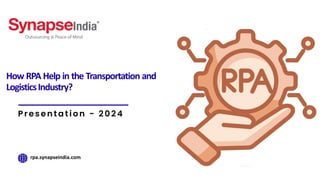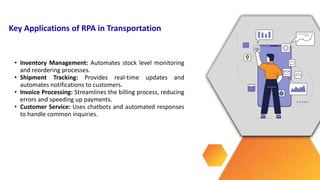How RPA Help in the Transportation and Logistics Industry.pptx
- 1. rpa.synapseindia.com Presentation - 2024 How RPA Help in the Transportation and LogisticsIndustry?
- 2. Definition: RPA stands for Robotic Process Automation, a technology that uses software robots to automate repetitive and routine tasks.RPA Help in the Transportation and Logistics Industry. Significance: It improves efficiency, accuracy, and productivity by automating mundane tasks, allowing human workers to focus on more strategic activities. Introduction to Robotic Process Automation
- 3. • Efficiency: Streamlines operations by automating scheduling, tracking, and reporting tasks. • Cost Reduction: Minimizes operational costs by reducing manual labor and errors. • Speed: Accelerates processes such as order processing and shipment tracking. • Compliance: Ensures adherence to regulatory requirements through accurate data handling Benefits of RPA in Transportation and Logistics
- 4. • Inventory Management: Automates stock level monitoring and reordering processes. • Shipment Tracking: Provides real-time updates and automates notifications to customers. • Invoice Processing: Streamlines the billing process, reducing errors and speeding up payments. • Customer Service: Uses chatbots and automated responses to handle common inquiries. Key Applications of RPA in Transportation
- 5. • Trends: Increasing adoption of AI and machine learning in RPA for predictive analytics and smarter automation. • Growth Potential: RPA market in transportation is expected to grow significantly, driving more innovations. • Challenges: Addressing security concerns and ensuring seamless integration with existing systems. Future of RPA in Transportation
- 6. • Case Study 1: A logistics company reduced manual processing time by 70% using RPA for shipment tracking. • Case Study 2: A transportation firm automated its invoicing system, cutting down processing time by 60% and reducing errors by 90%. Case Studies: RPA in Action
- 8. Liceria & Co. www.reallygreatsite.com For Your Attention THANK YOU







